[From Unsplash]
Good morning,
When invited to speak in public, most people feel afraid. Then there are those who appear to be at ease—natural storytellers it would appear. What sets them apart? It’s their emotional state. It emerges on the pages Originals by Adam Grant where he explains what it means to be calm on the one hand and excited on the other.
“If we want to understand how to manage fear, we don’t have to threaten people’s lives; we need only threaten to put them on stage. Alison Wood Brooks, a professor at Harvard Business School, asked college students to deliver a persuasive speech on why they would make good collaborators at work. A critical experimenter sat in the audience, and all the speeches were videotaped. A committee of peers would be enlisted later to evaluate each speaker’s persuasiveness and confidence. With only two minutes to prepare, many of the students were visibly shaking.
“If you were in this situation, how would you manage your fear? When Brooks asked three hundred working Americans to offer advice on this matter, the most popular recommendation was ‘Try to relax and calm down.’ This is the most obvious suggestion, favoured by more than 90 percent of professionals. Yet it isn’t the best one. Before the college students gave their speeches, Brooks asked them to speak three words out loud. She randomly assigned them to say either ‘I am calm’ or ‘I am excited.’
“That one word—calm versus excited—was sufficient to significantly alter the quality of their speeches. When students labelled their emotions as excitement, their speeches were rated as 17 percent more persuasive and 15 percent more confident than those of students who branded themselves calm. Reframing fear as excitement also motivated the speakers, boosting the average length of their speeches by 29 percent; they had the courage to spend an extra thirty-seven seconds on stage. In another experiment, when students were nervous before taking a tough math test, they scored 22 percent better if they were told ‘Try to get excited’ instead of ‘Try to remain calm.’
“To overcome fear, why does getting excited work better than trying to calm yourself down? Fear is an intense emotion: You can feel your heart pumping and your blood coursing. In that state, trying to relax is like slamming on the brakes when a car is going 80 miles per hour. The vehicle still has momentum. Rather than trying to suppress a strong emotion, it’s easier to convert it into a different emotion—one that’s equally intense, but propels us to step on the gas.”
Think it over!
The Oreo fascination
What are Oreo cookies and why do most people love them? The answer is embedded in an essay that Tejaswini Adhikari, one of our subscribers and Chief Insights Officer at the Future Group, pointed us to. This lovely essay by the anthropologist Kelly Alexander is on our fantasies about futuristic food.
She writes about how her interest in the theme “Was piqued when I read that more than 491 billion Oreos have been sold worldwide since 1912, making Oreos not only the best-selling cookie of all time but one of the best-selling brands. The Oreo is a fantastic case study in future deliciousness, because it is one of the most man-made foods in existence.
“Oreos are ‘accidentally vegan’ because they contain no fresh ingredients (even as the brand itself warns that milk, while not an ingredient in the cookie, could be a cross-contaminant due to factory conditions). They were made with lard until the mid-1990s, when the animal fat was swapped out with partially hydrogenated vegetable oil due to what were billed as ‘growing health concerns’. Since then, Oreos qualify as ‘accidentally Kosher’ too. It takes about an hour to make an Oreo cookie and, about three seconds to eat one.”
She surveyed more than 400 students to ask why they like Oreo and “Almost none, however, could describe exactly why. Asked what an Oreo tastes like, the number-one response to date is ‘home’, followed by ‘school’. The Oreo’s very conditions of existence were obscured by nostalgia.”
Alexander then goes on to explain that “An attachment to Oreos is based on a sense of being cared for and of belonging, which its makers exploit: they know that future-delicious foods evoke an era of optimism and unproblematic progress (namely the 1950s and ’60s), and they know that this now strikes many of us as naive, even destructive, when we consider the industrialised agriculture that’s enabled such products to literally wrap themselves around the globe. So, their strategy for this particular futuristic food has been to appeal to the past.”
Dig deeper
What our fantasies about futuristic food say about us
Talking clearly
Most people have trouble presenting their thoughts to an audience. Why? A post that hit our inboxes from Atoms and Bits attempts to answer that.
“Here is what it’s like to think

“Here is what it’s like to talk

“On some level, the entire problem of communication is the difficulty of pushing complicated bundles of inter-related thoughts through the low-dimensional space of your mouth.
“In trying to convey a complex 3-dimensional object through a series of 1-dimensional etchings, not only are you forced to straighten out complex curves into straight lines, you lose a ton of information about the relationships between the lines.
“This has various difficult consequences.
“Often, when I’m asked to give examples to support a point, there’s 6 different examples that collectively are the reason I believe that thing; they each add a bit of weight to my beliefs, but none of them are dispositive. When speaking, I have to pick a single one of them to linearise, and so my claims feel unconvincing even to me.
“Similarly, the decision of whether to include all relevant caveats is excruciating. If you have this bundle of thoughts and caveats

“You only have a few choices: express the main branch without the caveats

“Talk for a really long time, expressing the point and then all the caveats, by which point your listener has probably forgotten some of the point, and struggles to connect the caveats to the points.”
There are some other useful pointers from the author and we think it is worth thinking over.
Dig deeper
Pushing bundles of thought out of your mouth
Be natural
(Via WhatsApp)
Found anything interesting and noteworthy? Send it to us and we will share it through this newsletter.
And if you missed previous editions of this newsletter, they’re all archived here.
Warm regards,
Team Founding Fuel



